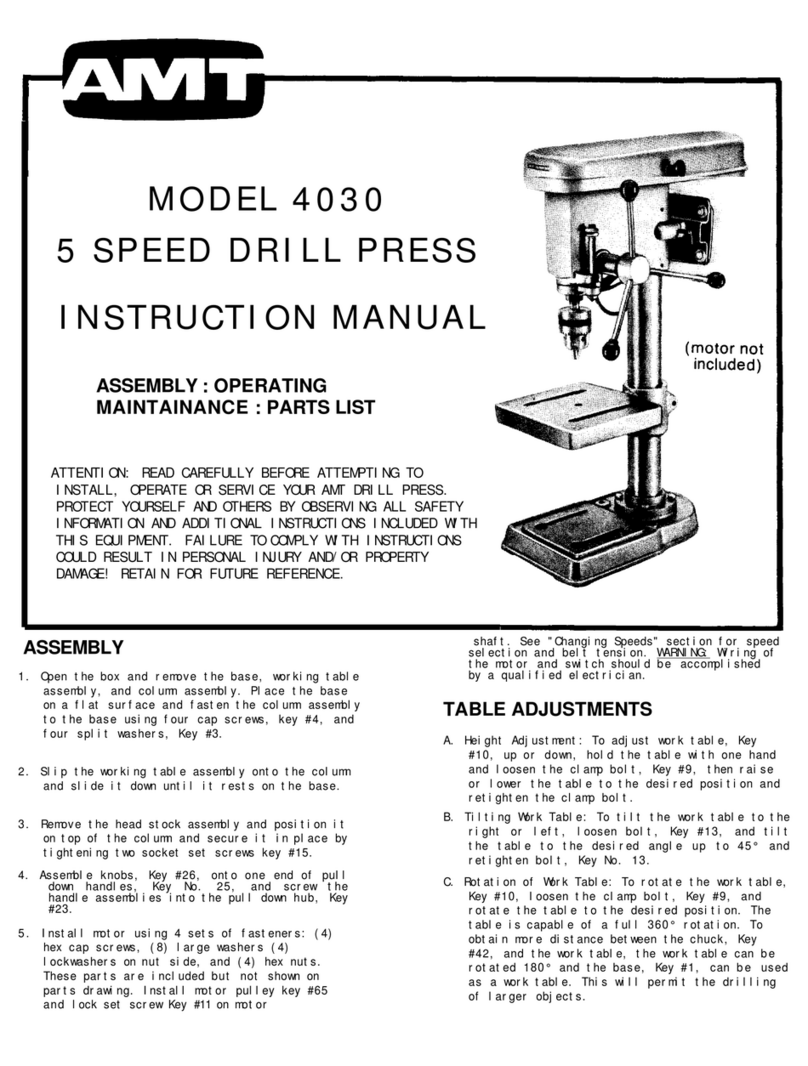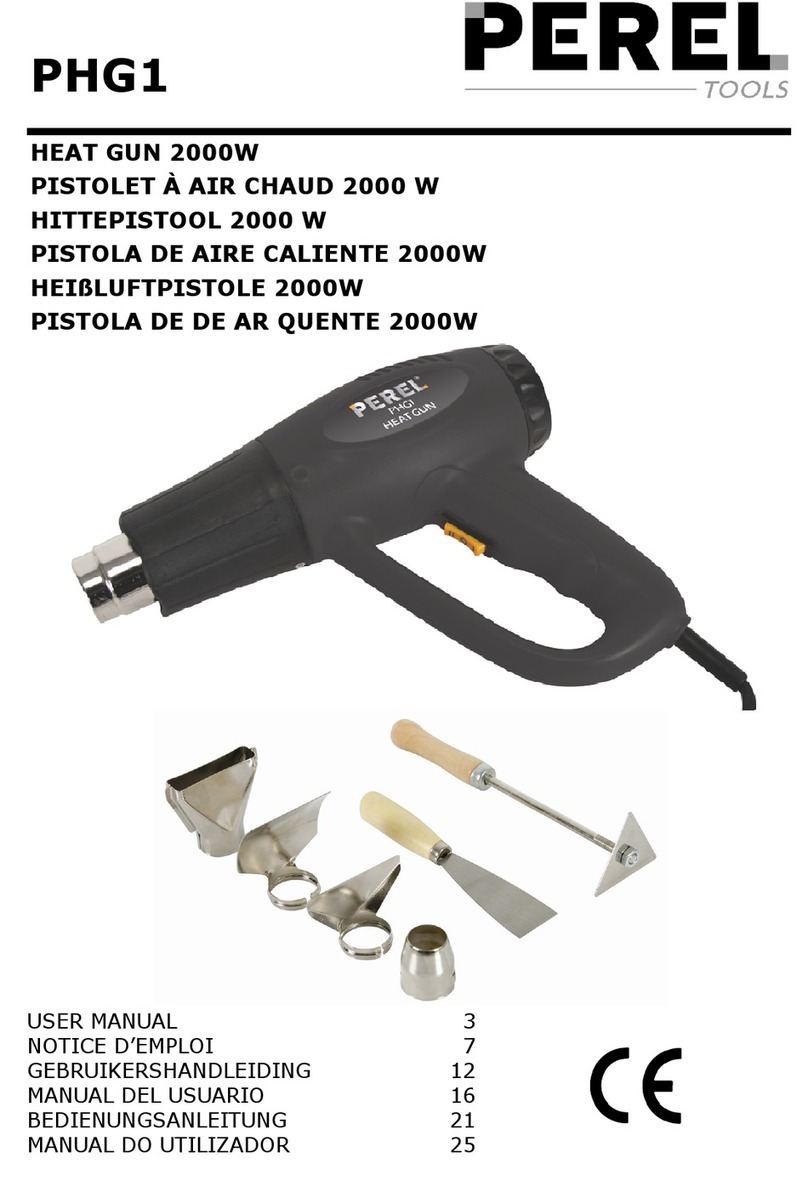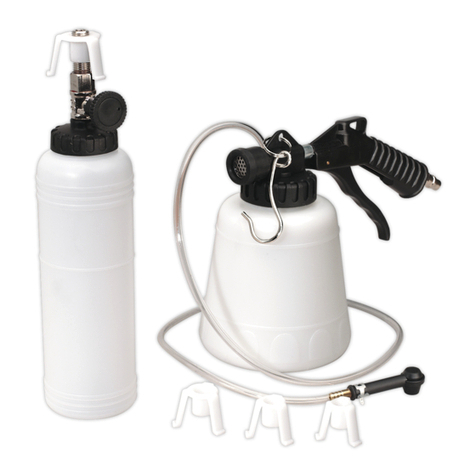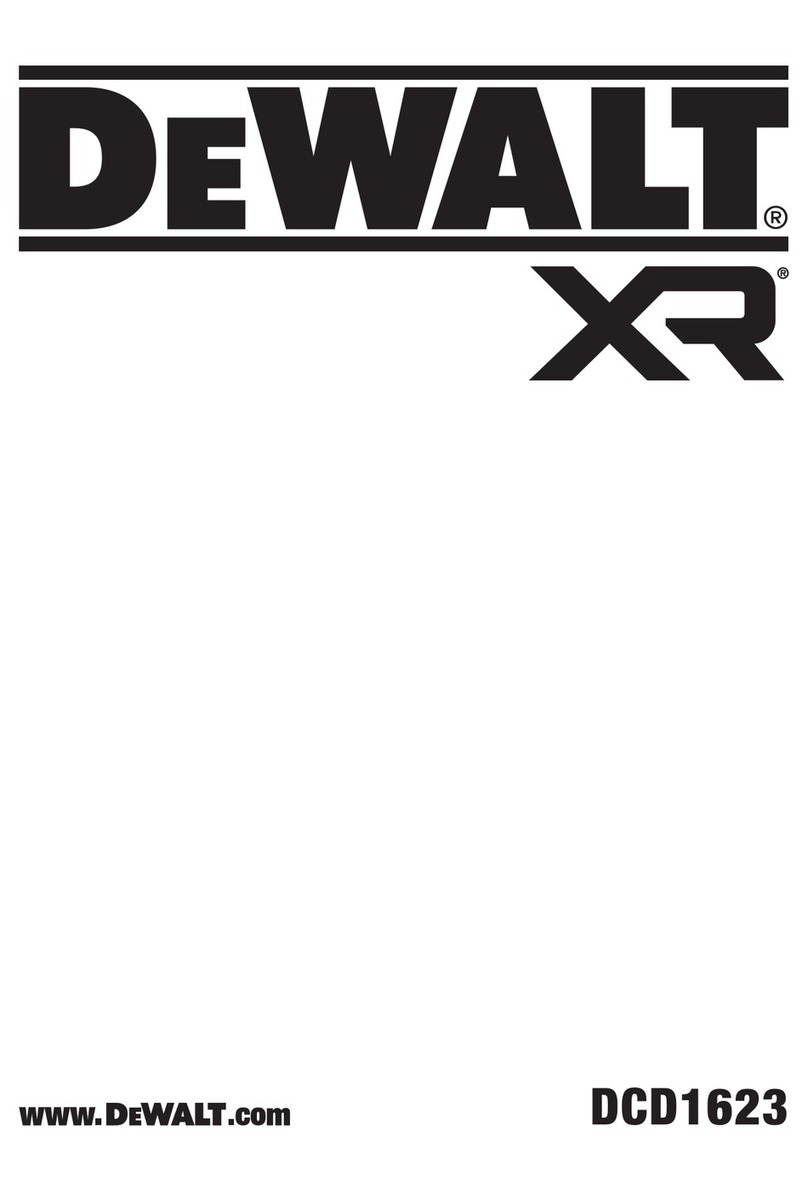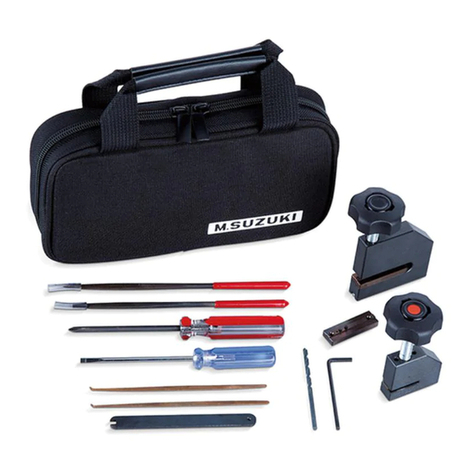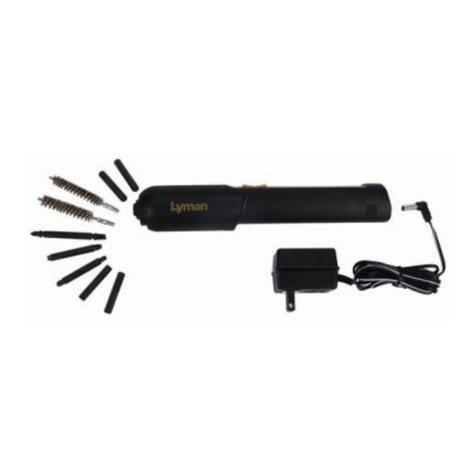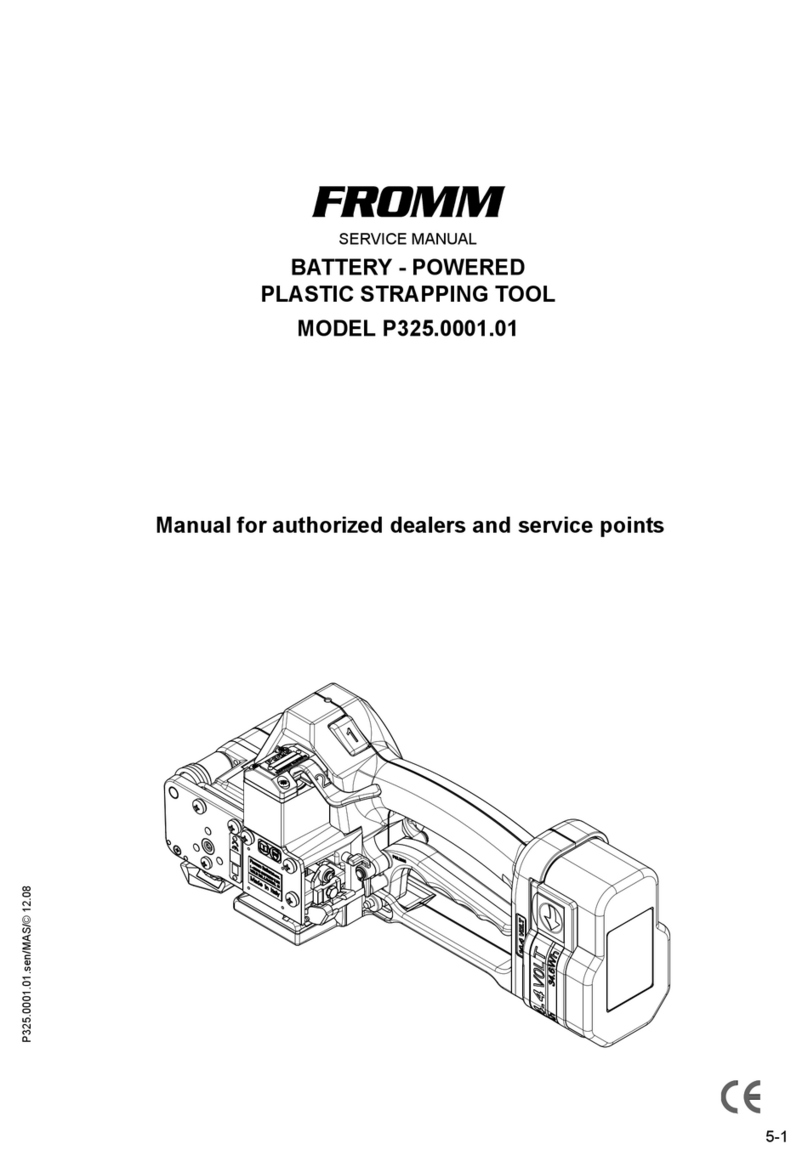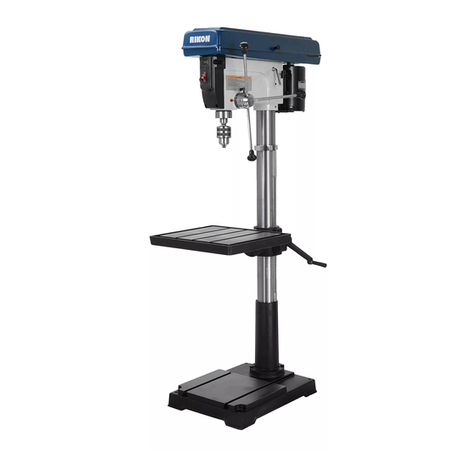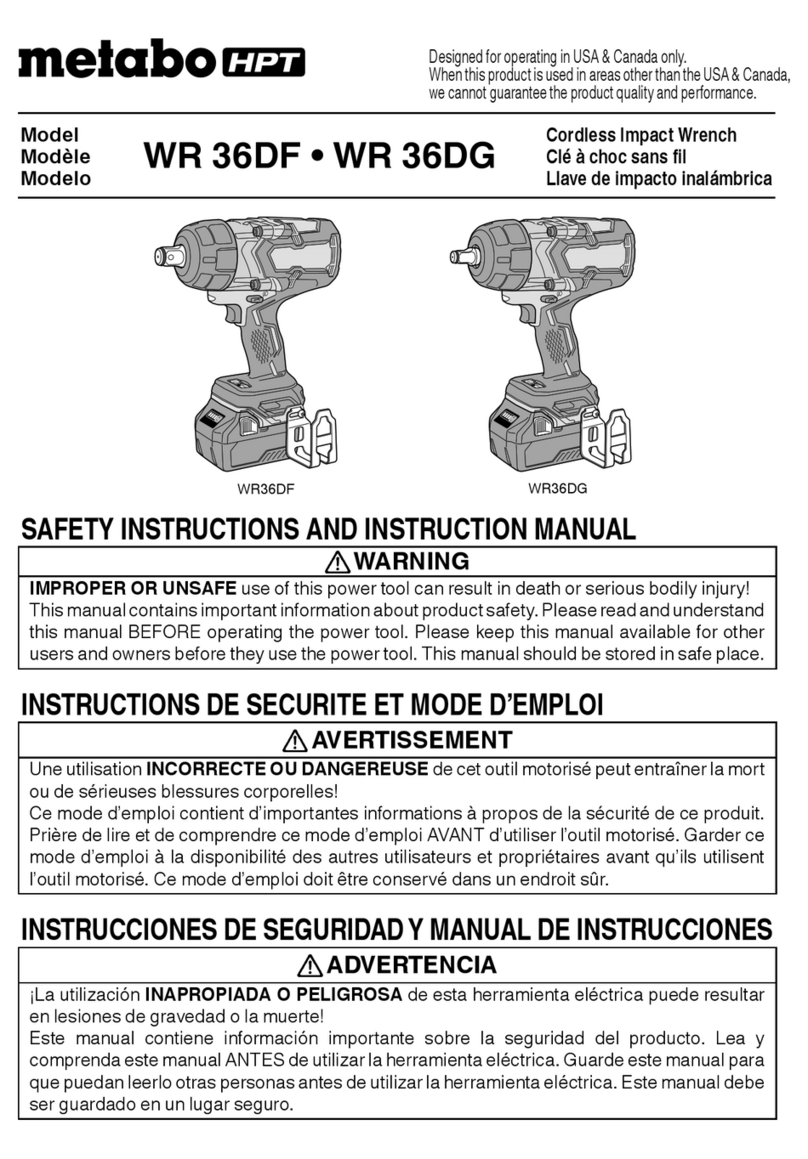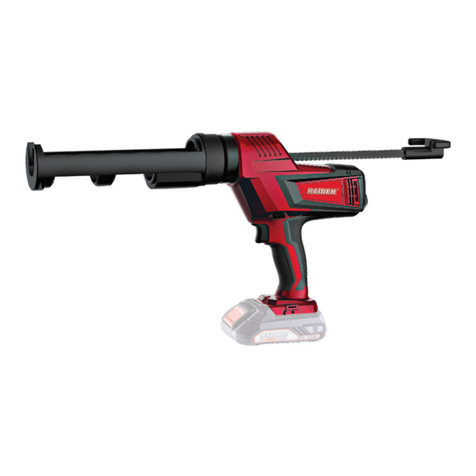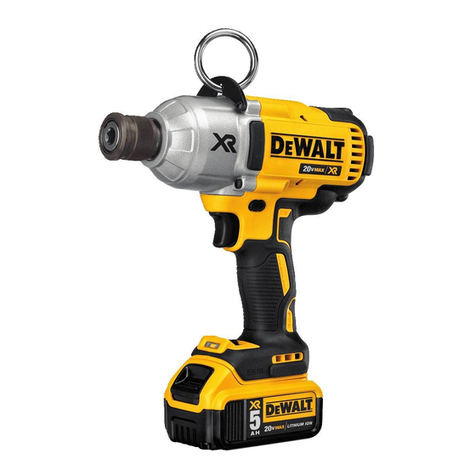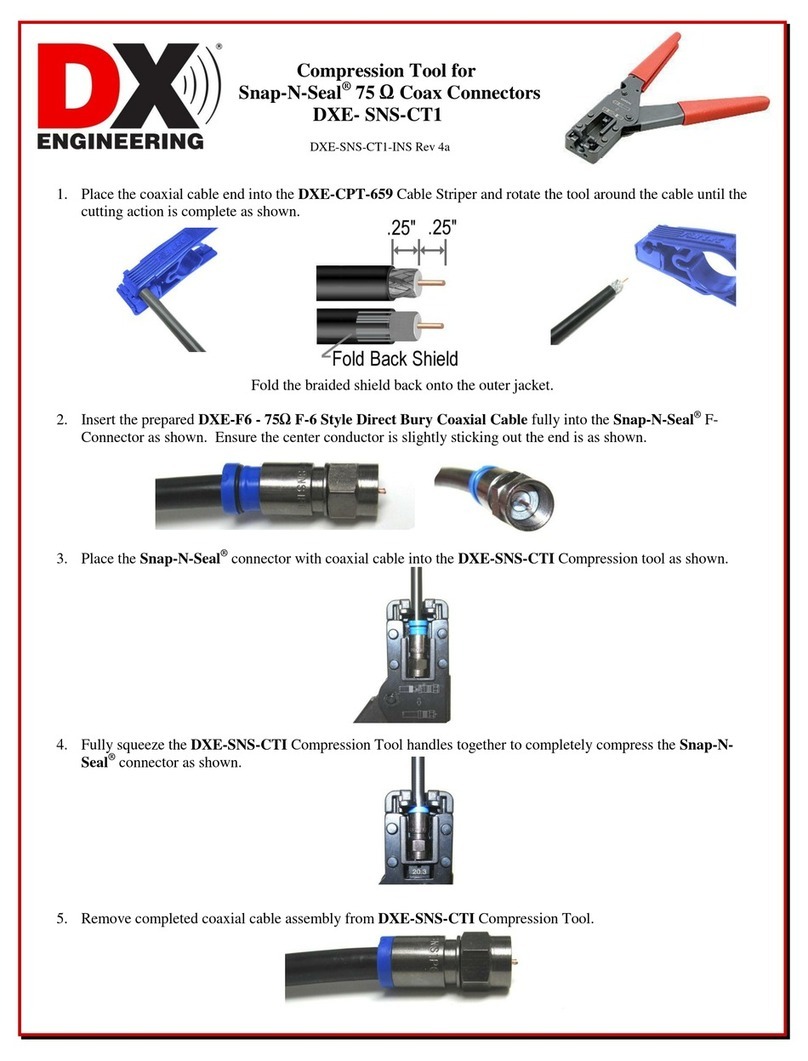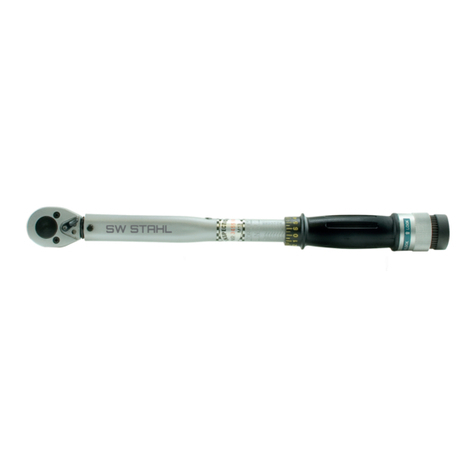BRADEN CH400B Manual

WRITE HOIST SERIAL NUMBER BELOW
}
First 2 numbers indicate
year manufactured
For serial number location see page 3
LIT2419 R4
April 2017
Printed in USA
©2017 PACCAR Inc.
All rights reserved
Visit our Web site at www.paccarwinch.com for the most comprehensive collection of winch, hoist, and drive
information on the Internet. Most publications and specification sheets are available for downloading.
CH400B
PLANETARY HOIST
INSTALLATION, MAINTENANCE,
AND SERVICE MANUAL
CH400B

TABLE OF CONTENTS
Foreword .....................................................................................................................3
Model and Serial Number Location .............................................................................3
Explanation of Model Number .....................................................................................3
Glossary ......................................................................................................................4
General Safety Recommendations..............................................................................5
Theory of Operation.....................................................................................................6
Hoist Installation ..........................................................................................................8
3-piece Cable Anchor Installation................................................................................9
Hydraulic Circuits.......................................................................................................10
Preventive Maintenance............................................................................................ 11
Weights, Oil Capacities, and Special Tools ...............................................................13
Recommended Planetary Gear Oil............................................................................13
Troubleshooting.........................................................................................................14
Service Precautions...................................................................................................17
Main Components .....................................................................................................17
Hoist Disassembly.....................................................................................................18
Hoist Assembly..........................................................................................................20
Drum Support End Bracket Service...........................................................................21
Hoist Drive Service....................................................................................................22
Brake Cylinder Service..............................................................................................25
Overrunning Clutch Service.......................................................................................27
Primary Planet Carrier Service..................................................................................28
Intermediate Planet Carrier Service ..........................................................................29
Final Planet Carrier Service.......................................................................................30
Brake Valve Service ..................................................................................................31
Recommended Fastener Torque ...............................................................................34
Metric Conversion Chart............................................................................................35

3
FOREWORD
Read this entire publication and retain it for future reference.
For inquiries regarding your BRADEN hoist or this publication, please contact BRADEN Service Department at 918-
251-8511, Monday through Friday, 8:00 a.m. to 4:30 p.m. (CST).
The minimum service intervals specied are for operating hours of the prime mover.
The following service instructions have been prepared to provide assembly, disassembly, and maintenance informa-
tion for the BRADEN Model CH330/CH400A series winch. It is suggested that before performing any work on these
units, all assembly and disassembly instructions should be read and understood.
Some illustrations in this manual may show details or attachments different from your hoist. Some components have
been removed for illustrative purposes. Drawings in this manual represent a typical unit sold through our distribution
channels. Some hoists, particularly those sold directly to original equipment manufacturers (OEM), may differ in appear-
ance and options.
EXPLANATION OF MODEL NUMBER
CH 400 B 87 120 - 01 - G - 1
CONSTRUCTION
HOIST
MAX
RATING
DESIGN
RATING
GEAR
RATIO
MOTOR
SIZE
DRUM
SIZE
OPTION
CH CONSTRUCTION HOIST
400 40,000-POUND DESIGN FIRST-LAYER LINE PULL
B MODEL SERIES RELATING TO DESIGN CHANGES
87 TOTAL GEAR REDUCTION
120 HYDRAULIC MOTOR DISPLACEMENT IN CU. IN/REV (120 = 12.0 CU. IN REV)
01 DRUM OPTION
G OTHER DRUM OPTIONS (G = GROOVED; M = MACHINED; P = RATCHET AND PAWL
U = UNDERWOUND)
1 PERMITS TESTING AND INSPECTION PER API 2C FOR OFFSHORE CRANES
DRUM
OPTION
Model numbers and serial numbers are
stamped into the motor end bracket as
shown at right. Always refer to the model
number and serial number when requesting
information or service parts.
WARNING – This emblem warns against hazards
and unsafe practices which COULD result in severe
personal injury or death if proper procedures are not
followed.
CAUTION
WARNING
! !
CAUTION – This emblem warns against potential or
unsafe practices which COULD result in personal in-
jury and product or property damage if proper proce-
dures are not followed.
CAUTION
Safety Informational callouts used in this manual include the following:

4
Brake Valve — A hydraulic counterbalance valve is usually bolted to the hoist port of the hydraulic motor. It allows oil
to ow freely through the motor in the hoisting direction. When oil pressure tries to rotate the motor in the lowering
direction, the brake valve blocks the ow of oil out of the motor until the internal static brake is released. It then controls
lowering speed based on the load and ow of oil to the motor. All the heat generated by controlling the speed of the
load is dissipated by the hydraulic system, not by the internal static brake.
Sprag or Overrunning Clutch — A mechanical one-way clutch on the input shaft of the hoist, between the input shaft
and the static mechanical brake. The clutch allows the input shaft to turn freely in the direction required to spool cable
onto the drum (such as lift a load), then immediately locks the hoist gear train to the mechanical brake when the hoist
is stopped, holding the load in place.
Static, Mechanical, or Load-holding Brake — A multidisc, spring applied, hydraulically released brake that works
together with the sprag clutch to hold a suspended load. This brake is not designed to stop a load being lowered, but
holds the load in place when the hoist is not being operated.
First Layer Line Pull Rating — The maximum rated line pull (in pounds or kilograms) on the rst layer of cable. The
maximum rating for any particular hoist is based on maintaining an acceptable structural design factor and service life.
Certain combinations of drum, gear ratio, motor and hydraulic pressure, may reduce this rating.
First Layer Line Speed Rating — The maximum rated line speed (in feet or meters per minute) on the rst layer of
cable. Certain combinations of drum, gear ratio, motor and hydraulic ow may reduce or increase this rating.
D/d Ratio — The ratio of cable drum barrel diameter (D) to wire rope diameter (d). Current ANSI standards require a
minimum of 17:1.
EXAMPLES:
If you know the cable diameter you want to use, multiply it by 17 to get the MINIMUM cable drum barrel diameter. (such
as 1/2-inch wire rope X 17 = 8.5 inches — this is the minimum hoist barrel diameter)
If you know the barrel diameter, divide it by 17 to get the MAXIMUM wire rope diameter.
(such as 10-inch barrel diameter / 17 = 0.588, or 9/16-inch — this is the maximum wire rope diameter)
Cable Drum Dimensions —
a
b
First sheave
or load
GLOSSARY
First sheave or load should be cen-
tered between the drum anges, so
that angle A and angle B are equal.
Angles A and B should be a minimum
of 1/2 degree and a maximum of 1-1/2
degrees.
Wrap — A single coil of wire rope wound on a drum.
Layer — All wraps of wire rope on the same level between drum anges.
Freeboard — The amount of drum ange that is exposed radially past the last layer of wire rope. Minimum freeboard varies with
the regulatory organization. ASME B30.5 requires 1/2-inch minimum freeboard.
Grooved Drum — A cable drum with grooves on the barrel to ensure the
rst layer of cable spools properly onto the drum. The grooves can be cast
or machined into the drum, or cast or machined into separate pieces that are
mechanically fastened to the drum.
NOTE: Only one size cable can be used on a grooved drum.
Barrel
Diameter
Flange
Diameter
Distance
Between
Flanges
Fleet Angle — The angle between the wire rope’s position at the extreme end wrap on a drum, and a line drawn per-
pendicular to the axis of the drum, through the center of the nearest xed sheave or load attachment point.

5
GENERAL SAFETY RECOMMENDATIONS
Safety for operators and ground personnel is of prime concern. Always take the necessary precautions to ensure safety
to others as well as yourself. To ensure safety, the prime mover and hoist must be operated with care and concern by
the operator for the equipment, and a thorough knowledge of the machine’s performance capabilities. The following
recommendations are offered as a general safety guide. Local rules and regulations will also apply.
1. Be certain equipment (boom, sheave blocks, pendants, etc.)
is either lowered to the ground or blocked securely before
servicing, adjusting, or repairing hoist.
2. Be sure personnel are clear of work area BEFORE operat-
ing hoist.
3. Read all warning and caution tags provided for safe opera-
tion and service of the hoist and become familiar with the
operation and function of all controls before operating the
hoist.
4. Inspect rigging and hoist at the beginning of each work shift.
Defects should be corrected immediately. Do not operate a
hoist with defects.
5. Keep equipment in good operating condition. Perform
scheduled servicing and adjustments listed in the Preven-
tive Maintenance section of this manual.
6. An equipment warm-up procedure is recommended for
all start-ups and essential at ambient temperatures below
+40°F (+4°C). Refer to “Warm-up Procedure” listed in the
Preventive Maintenance section of this manual.
7. Do not exceed the maximum pressure (PSI, kPa) or ow
(GPM, lpm) stated in the hoist specications found in the
specic sales brochure.
8. Operate hoist line speeds to match job conditions.
9. Protective gloves should be used when handling wire rope.
10. Never attempt to handle wire rope when the hook end is not
free. Keep all parts of body and clothing clear of cable roll-
ers, cable entry area of fairleads, sheaves and hoist drum.
11. When winding wire rope on the hoist drum, never attempt to
maintain tension by allowing wire rope to slip through hands.
Always use the hand-over-hand technique.
12. Never use wire rope with broken strands. Replace wire rope
that is damaged. Refer to wire rope supplier manual.
13. Do not weld on any part of the hoist without approval from
PACCAR Winch Engineering.
14. Use only recommended hydraulic oil and gear lubricant.
15. Keep hydraulic system clean and free from contamination at
all times.
16. Use correct size cable anchor for wire rope and pocket in
hoist drum.
17. Do not use knots to secure or attach wire rope.
18. The BRADEN designed wire rope anchors are not intended
to support the rated load. ALWAYS maintain a minimum of
ve wraps of wire rope on the drum. It is recommended that
the last ve wraps of wire rope be painted bright red to serve
as a visual reminder.
19. Never attempt to clean, oil or perform any maintenance on
a machine with the engine or prime mover running, unless
instructed to do so in this manual.
20. Never operate hoist controls unless you are properly posi-
tioned at the operators station and you are sure personnel
are clear of the work area.
21. Assure that personnel who are responsible for hand signals
are clearly visible and that the signals to be used are thor-
oughly understood by everyone.
22. Ground personnel should stay in view of the operator and
clear of the hoist drum. Do not allow ground personnel near
wire rope under tension. A safe distance of 1-1/2 times the
working length of the wire rope should be maintained.
23. Install guarding to prevent personnel from getting any part
of body or clothing caught at a point where the cable is
wrapped onto the drum or drawn through guide rollers or
potential pinch points.
24. Install switches or valves that will shut off power to the hoist,
in locations where they can be reached by anyone entan-
gled in the wire rope before being drawn into the hoist or any
pinch point.
25. Deadman controls, which automatically shut off power to the
hoist whenever the operator leaves his station or releases
the hoist control lever, should be installed whenever practi-
cal.
26. Never allow anyone to position any part of body under a
suspended load.
27. Avoid sudden shock loads or attempting to jerk a load free.
This type of operation may cause heavy loads, in excess of
rated capacity, which may result in failure of wire rope, hoist
or crane structure.
28. Whenever possible, install the hoist in a location that is not
immediately adjacent to a “normal” operator’s station.
29. All hoist controls shall be located within easy reach of the op-
erator. The controls shall be installed in such a location that
the operator is removed from the electrical path to ground if
the load, rigging, or wire rope come in contact with or within
proximity to an electrically energized conductor.
30. Before operating the hoist, be sure ALL safety procedures
for the equipment or vehicle the hoist is mounted on are
properly followed and/or in place.
Failure to obey the following safety recommendations may
result in property damage, personal injury, or death.

6
THEORY OF OPERATION
DESCRIPTION OF HOIST
The hoist is made up of the following sub-assemblies and
parts:
1. Hydraulic motor, brake valve and motor adapter
2. Drum and drum support assembly
3. Motor end support
4. Tie plates
5. Brake clutch assembly
6. Drive assembly with multiple disc parking brake and
internal gearing
DUAL BRAKE SYSTEM
DESCRIPTION
The dual brake system consists of a dynamic brake sys-
tem and a static brake system.
The dynamic brake system has two operating compo-
nents:
1. Brake valve assembly
2. Hydraulic motor
The brake valve is basically a counterbalance valve. It
contains a check valve to allow free ow of oil to the motor
in the haul-in direction and a pilot operated, spring load-
ed spool valve that blocks the ow of oil out of the motor
when the control valve is placed in neutral. When the con-
trol valve is placed in the pay-out position, the spool valve
remains closed until sufcient lowering pressure is applied
to the end of the spool to shift it against spring pressure
and open a passage. After the spool valve cracks open,
the lowering pressure becomes ow dependent and mod-
ulates the spool valve opening which controls the lowering
speed. See Figures 1, 2, and 3. The static brake system has three operating components:
1. Spring applied, hydraulically released multiple friction
disc brake pack
2. Brake clutch assembly
3. Hydraulic piston and cylinder
The static brake is released by lowering pressure at a
pressure lower than that required to open the brake valve.
This sequence assures that dynamic braking takes place
in the brake valve and little, if any, heat is absorbed by the
friction brake.
The friction brake is a load-holding brake only and has
nothing to do with dynamic braking or rate of descent of a
load. The inner race of the brake clutch is a splined cou-
pling between the motor and the primary sun gear. The
outer race is splined to the friction discs in the brake pack,
while steel separator plates are splined to the stationary
housing. The brake clutch allows this shaft to turn freely
in the haul-in direction, and locks up to force the brake
discs to turn with the shaft in the pay-out direction. See
Figures 4 and 5.
Motor
Control Valve
Pump
To Tank
Brake Valve
Static Brake
Medium
Pressure
Low
Pressure
High
Pressure
Figure 1
Figure 2
Figure 3
Motor
Control Valve
Pump
To Tank
Brake Valve
Static Brake
Medium
Pressure
Low
Pressure
High
Pressure
Motor
Control Valve
Pump
To Tank
Brake Valve
Static Brake
Medium
Pressure
Low
Pressure
High
Pressure

7
Spring pressure on the steel end friction brake discs pre-
vent the brake discs from turning until the hydraulic cylin-
der and piston are pressurized, releasing the force on the
brake discs and creating clearance between the friction
and steel discs..
OPERATION
When hauling-in cable, or hoisting a load, the motor shaft
and hoist gear train turn freely as the sprag cams lay over
between the inner and outer races of the brake clutch.
See Figure 4.
The multiple disc friction brake remains fully engaged and
the hoist is not affected by any braking action when hoist-
ing. See Figure 1.
When hoisting is stopped, the load tries to turn the hoist
drum, gear train, and primary sun gear in the reverse di-
rection. This reversed input to the inner race of the brake
clutch causes the sprag cams to instantly roll upward and
lock the shaft to the fully engaged friction brake. See Fig-
ure 5.
Sprag Cams
Sprag Cams
Figure 5
Figure 4
Static Friction Brake Applied
Static Friction Brake Applied
When the hoist is powered in the pay-out or lowering di-
rection, the motor cannot rotate until sufcient lowering
pressure is present to release the brake and open the
brake valve. See Figures 2 and 3. The friction brake will
completely release at a pressure lower than that required
to open the brake valve. The extent to which the brake
valve opens determines the amount of oil that can ow
through the motor, which is directly related to the drum
speed of the hoist. Increasing the ow of oil to the hoist
motor causes the pilot pressure to rise which increases
the opening in the brake valve, allowing more oil to ow
through the motor and increasing the drum speed. De-
creasing this oil ow causes the pilot pressure to drop,
reducing the opening in the brake valve which slows the
motor and hoist speed.
The friction brake receives little, if any, wear in the pay-out
or lowering operation. All of the heat generated by lower-
ing and stopping a load is absorbed by the hydraulic oil
where it can be readily dissipated.
When the control valve is shifted to neutral, pilot pressure
drops closing the brake valve spool, stopping the motor
and the load. The friction brake then engages and holds
the load after the brake valve has closed.
When lowering a load slowly for precise positioning, no
oil ow actually occurs through the pilot operated spool
in the brake valve. Pressure builds up to a point where
the friction brake will release sufciently to allow the load
to rotate the motor through its own internal leakage. This
feature results in a slow speed and extremely accurate
positioning.
HOIST OPERATION
The input section of the drive assembly is bolted to the
motor end support and cannot rotate. The drive housing
is the output member of the gear set and is bolted to the
hoist drum. The motor shaft is directly coupled to the pri-
mary sun gear through the inner race of the brake clutch.
The motor turns the primary sun gear which drives three
successive planetary gear sets, turning the drive housing
and the hoist drum.
In the haul-in direction, hydraulic oil ows through a large
check valve in the brake valve and turns the motor in the
free rotating direction of the brake clutch, driving the gear
train and hoist drum. The friction brake remains fully en-
gaged.
In the pay-out direction, oil ow through the motor is ini-
tially blocked by a spool in the brake valve. Oil pressure
supplied to the motor through the control valve is piloted
to the friction brake and the brake valve spool. The friction
brake is released at a lower pressure than that required to
shift the brake valve spool. When pressure is sufcient to
shift the brake valve spool, oil is allowed to ow through
the motor, rotating the hoist gear train and drum.
Permits free shaft rotation
while hoisting
Load attempts to rotate shaft in opposite direction
Brake clutch locks sun gear shaft to friction brake

8
HOIST INSTALLATION
1. The hoist should be mounted with the centerline of
the cable drum in a horizontal position. The mount-
ing plane of the hoist may be rotated in any position
around this centerline providing the vent in the motor
adapter is above the centerline of the cable drum. The
vent should be as close to top dead center as pos-
sible.
2. When mounting the hoist, use all four mounting holes
and Grade 8 bolts and nuts. Evenly tighten the nuts
to the torque in the Recommended Fastener Torque
chart in this manual. Make certain the hoist drum is
centered behind the rst sheave and the eet angle
does not exceed 1-1/2 degrees. The hoist should also
be mounted perpendicular to an imaginary line from
the center of the drum to the rst sheave to ensure
even spooling.
Refer to dimensional drawing in this manual and in sales
brochure for bolt hole size and pattern.
It is important that the hoist is mounted on a surface that
will not ex when the hoist is in use, and cause binding of
the gear train. Binding in the gear train will result in accel-
erated wear and heat. Also, the mounting surface should
be at with +/- 0.020 inch. If necessary, install shims un-
der the hoist mounting pads to achieve even mounting.
3. The hydraulic lines and components that operate the
hoist should be of sufcient size to assure minimum
back pressure at the hoist. The back pressure at the
motor must not exceed 100 PSI (690 kPa) to maintain
full brake system design factor and optimum motor
seal life for gear motors, 30 PSI (207 kPa) for piston
motors. On all piston motors and on gear motors with
backpressures above 50 PSI, an external line should
be plumbed directly to tank from the motor case drain.
On tandem motors (two inlet and two outlet ports on
the motor) that have two case drain ports, the larger
center case drain should be plumbed to tank.
The hoist directional control valve must be a three-posi-
tion four-way valve with a motor spool such that when the
valve is in the center position both work ports are open
to tank (open center, open port), and must be spring-
centered and without detents.
4. High-quality hydraulic oil is essential for satisfactory per-
formance and long hydraulic system component life.
Oil having 150 to 330 SUS viscosity at 100°F (38°C) and
viscosity index of 100 or greater will give good results un-
der normal temperature conditions. The use of an oil hav-
ing a high viscosity index will minimize cold start trouble
and reduce the length of warm-up periods. A high vis-
cosity index will minimize changes in viscosity with cor-
responding changes in temperature.
Maximum cold weather start-up viscosity should not ex-
ceed 5,000 SUS with a pour point at least 20°F (11°C)
lower than the minimum ambient temperature.
Under continuous operating conditions the temperature of
the oil at any point in the system must not exceed 180°F
(82°C). 120°F (49°C) to 140°F (60°C) is generally consid-
ered optimum.
In general terms:
For continuous operation at ambient temperatures be-
tween 50°F (10°C) and 110°F (43°C) use SAE 20W; for
continuous operation between 10°F (-12°C) and 90°F
(32°C) use SAE 10W; for applications colder than 10°F
(-12°C), contact the BRADEN Service Department. The
use of multiviscosity oils is generally not recommended.
For hoist gear oil, refer to lubricant specications in the
Preventive Maintenance and Specications section of this
manual.
5. The hydraulic oil lter should have a 10-micron nomi-
nal rating and be full-ow type.
6. The vent plug in the motor adapter (and auxiliary brake
end if equipped) must be located as close to top dead
center as possible. If the hoist is mounted on a pivot-
ing surface, the vent plug must remain above the cen-
terline of the cable drum to prevent gear oil leakage.
7. Refer to dimensional drawing for relationship between
drum rotation and which port is pressurized.
Recommended Control-
valve Schematic
DO NOT use a control valve with any detents or latch-
ing mechanism that would hold the control valve in an
actuated or running position when the operator releas-
es the control handle. Use of the wrong type of control
valve could lead to unintentional operation of the hoist,
which could result in property damage, personal injury,
or death.
THE CABLE ANCHORS ALONE ON HOISTS ARE
NOT DESIGNED TO HOLD RATED LOADS. Loads
applied directly to the wire rope anchor may cause the
wire rope to pull free and result in the sudden loss of
load control and cause property damage, personal inju-
ry, or death. A minimum of ve wraps of wire rope must
be left on the drum barrel to achieve rated load.

9
WIRE ROPE INSTALLATION
Remove both sheet metal covers from the end bracket of
the hoist. Pull the end of the cable through the opening in
the drum ange and out through the end bracket as shown
in Figure 1. Form the cable around part 1 of the wedge as
shown in Figure 2, and pull the assembly into the anchor
pocket (part 2 and the nut are not attached to part 1 at this
time). Access the threaded rod attached to part 1 through
the other opening in the end bracket and install part 2 and
the nut. On large diameter cable, it may be necessary to
hammer on the cable looped around part 1 to force it far
enough into the anchor pocket to attach part 2.
It is important for the dead end of the cable to extend be-
yond the end of part 2, as shown in Figure 2, but not far
enough to come in contact with the end bracket when hoist
is operating. A load should be applied to the live end of the
cable to properly seat the anchor. After initial load is ap-
plied, tighten nut holding part 2 in place to 11 ft-lbs. A mini-
mum of ve wraps of wire rope should remain on the cable
drum at all times. Refer to General Safety Recommenda-
tions section of this manual for additional information.
3-piece Cable Anchor Installation
Install threaded rod (Item 3) into Item 1 until it bottoms,
then tighten jam nut (Item 2) against Item 1.
These surfaces face toward
drum ange when installed.
Figure 3
SPECIAL OFFSHORE BREAKAWAY ANCHOR
NOTE: Conrm that the cable
clamp assembly is suitable
for your rope size by read-
ing the size range (in inches)
stamped on part itself.
Feed cable through opening in drum ange until it extends
outside cable pocket 2 to 4 inches.
Insert partially assembled anchor (Items 1, 2, 3) into the
cable pocket with at side of Item 1 against the drum
ange. The anchor will wedge between the cable and the
top of the cable pocket.
Working from the other end of the cable pocket, install
Item 4 onto the threaded rod. Be sure to place the at side
of Item 4 against the drum ange, then install the rounded
end onto the threaded rod rst so the washer (Item 5) and
locknut (Item 6) will seat against the at end.
Install the washer and locknut onto the threaded rod and
tighten securely to 45 ft-lbs. (This is the torque value of the
1/2-13 stainless-steel rod).
Apply a light load of 1,000 to 2,000 pounds on the cable
and carefully spool it onto the drum. Retighten the nut
again to 45 ft-lbs. As previously stated in the warning on
preceding page, the cable anchor is not designed to hold
the rated load of the hoist. DO NOT apply full rated load
until ve or more wraps of cable are on the drum.
Example
01 AND 02 DRUM – ANCHOR
Remove both sheet metal covers from the end bracket
of the winch. Pull the end of the cable through the
opening in the drum flange and out through the end
bracket as shown in figure 1. Form the cable around
part 1 of the wedge as shown in figure 2, and pull the
assembly into the anchor pocket (part 2 and the nut are
not attached to part 1 at this time). Access the threaded
rod attached to part 1 through the other opening in the
end bracket and install part 2 and the nut. On large
diameter cable, it may be necessary to hammer on the
cable looped around part 1 in order to force it far
enough into the anchor pocket to attach part 2. It is
important for the ‘dead’ end of the cable to extend
beyond the end of part 2, as shown in figure 2, but not
far enough to come in contact with the end bracket
when the winch is operating. A load should be applied
to the ‘live’ end of the cable to properly seat the anchor.
After the initial load is applied, check the tightness of
the nut holding part 2 in place and tighten it if required.
A minimum of five (5) wraps of wire rope should remain
on the cable drum at all times. Refer to “General Safety
Recommendations” for additional information.
–– 7 ––
Figure 1
Figure 2
HYDRAULIC CIRCUITS
SINGLE SPEED CIRCUIT 2 SPEED CIRCUIT
Part
2
Part
1

10
OIL DRAIN
PLUG
B
C
2.03
(51.6)
HOISTING PORT
SAE 1 1/2”
4 BOLT SPLIT
FLANGE PORT
20.00
(508)
32.5
(825.5)
6.49
(164.8) 6.49
(164.8)
A
20.00
(508)
10.00
(254)
6.25
(158.75)
16.75
(425.5)
LOWERING PORT
SAE 1 1/2”
4 BOLT SPLIT
FLANGE PORT
17.98
(456.7)
35.97
(913.6)
HOIST
33.00
(838.2)
01 Drum 02 Drum 21 Drum
A23.88 (606.6) 38.12 (968)54.62 (1387)
B34.29 (871) 48.54 (1233) 69.1 (1755)
C38.35 (974.1) 52.6 (1336)69.1 (1755)
HYDRAULIC CIRCUITS
WINCH BRAKE
BRAKE
VALVE
PUMP
CONTROL
VALVE
WINCH ASSEMBL
Y
W/BRAKE VALVE
& STATIC BRAKE
BR
DR
HOIST LOWER
WINCH BRAKE
BRAKE
VALVE
2-SPEED
SELECTOR
VALVE
PUMP
CONTROL
VALVE
WINCH ASSEMBLY
W/BRAKE VALVE
& STATIC BRAKE
TP
BR
DR
A
LOWER
HOIST
CUSTOMER
SUPPLIED
SINGLE-SPEED CIRCUIT 2-SPEED CIRCUIT
DIMENSIONAL

11
PREVENTIVE MAINTENANCE
A regular program of preventive maintenance for your
planetary hoist is strongly recommended to minimize the
need for emergency servicing and promote safe, reliable
hoist operation.
Field experience, supported by engineering tests, indi-
cates the three service procedures listed below are the
MOST critical to safe, reliable hoist operation and must
be observed.
• Regular Gear Oil Changes – every 1,000 hours or
six months
• Use of Proper Gear Oil – recommended type for pre-
vailing ambient temperature
• Annual Disassembly and Inspection of All Wear
Items – in compliance with American National Stan-
dards Institute (ANSI) specication B30.5c 1987 and
American Petroleum Institute (API) recommended
practice RP 2D section 3.
The following minimum service intervals are specied for
operating hours of the prime mover.
1. Oil Level
The gear oil level should be checked every 500 operat-
ing hours or three months, whichever occurs rst. Oil
level should be even with the centerline of the hoist
drum visible in the sight gauge. If additional oil in
needed, refer to the Recommended Planetary Gear
Oil section of this manual.
2. Oil Change
The gear oil should be changed after the rst 100 hours
of operation, then every 1,000 operating hours or six
months, whichever occurs rst. The gear oil must be
changed to remove wear particles that impede the reli-
able and safe operation of the brake clutch and erode
bearings, gears and seals. Failure to change gear oil at
these suggested minimum intervals may contribute to
intermittent brake slippage which could result in prop-
erty damage, severe personal injury, or death.
Rotate the drum until the –8 drain plug is aligned with
the lowest opening in the drum end support plate. In-
stall a short piece of 1-inch pipe through the end plate.
Reach through the pipe with a 5/16 hex Allen wrench
and remove the –8 plug to drain the oil. Install the –8
plug and remove the 1-inch pipe when all the oil has
been drained from the drum. Although gear oil circu-
lates between the drive and the drum through holes in
the primary ring gear, it is advisable to also remove the
plug in the hoist drum.

12
The gear oil should also be changed whenever the am-
bient temperature changes signicantly and an oil from
a different temperature range would be more appropri-
ate. Oil viscosity with regard to ambient temperature is
critical to reliable brake clutch operation. Make certain
that the gear oil viscosity used in your hoist is correct
for your prevailing ambient temperature. Failure to use
the proper type and viscosity of planetary gear oil may
contribute to brake slippage which could result in prop-
erty damage, severe personal injury, or death. Refer to
the Recommended Planetary Gear Oil section of this
manual for additional information.
3. Vent Plug
The vent plug is located directly above the hoist mo-
tor near the brake release port. It is important to keep
this vent clean and unobstructed. Whenever gear oil is
changed, remove vent plug, clean in solvent and rein-
stall.
Do not paint over the vent or replace with a solid plug.
4. Hydraulic System
The original lter element should be replaced after
the rst 50 hours of operation, then every 500 operat-
ing hours or three months, or in accordance with the
equipment manufacturer’s recommendations.
5. Wire Rope
Inspect entire length of wire rope according to wire
rope manufacturer’s recommendations.
6. Mounting Bolts
Tighten all hoist base mounting bolts to recommended
torque after the rst 100 hours of operation, then every
1,000 operating hours or six months, whichever oc-
curs rst.
7. Warm-up Procedures
A warm-up procedure is recommended at each start-up
and is essential at ambient temperatures below +40°F
(4°C).
The prime mover should be run at its lowest recom-
mended RPM with the hydraulic hoist control valve
in neutral allowing sufcient time to warm up the sys-
tem. The hoist should then be operated at low speeds,
forward and reverse, several times to prime all lines
with warm hydraulic oil, and to circulate gear lubricant
through the planetary gear sets.
8. Recommended Planetary Gear Oil
Field experience, supported by extensive engineering
tests, indicates the use of the proper planetary gear oil
is essential to reliable and safe operation of the brake
and obtaining long gear train life. Refer to “Recom-
mended Planetary Gear Oil” for additional information.
9. Grease
Every 1,000 hours or six months grease drum support
at grease tting using an NLGI #2 Lithium complex
base extreme-pressure (EP) grease that meets or ex-
ceeds NLGI GC or GC/LP specications..
10.Inspection
In compliance with ANSI specication number
B30.5c1987 and API Recommended Practice RP 2D
section 3, we recommend that the hoist be disassem-
bled for a thorough inspection of all wear items every
2,000 hours of operation or 12 months, whichever oc-
curs rst.
Failure to properly warm up the hoist, particularly un-
der low ambient temperature conditions, may result in
temporary brake slippage due to high back pressures
attempting to release the brake, which could result in
property damage, severe personal injury, or death.
Failure to use the proper type and viscosity of planetary
gear oil may contribute to intermittent brake clutch slip-
page which could result in property damage, severe
personal injury, or death. Some gear lubricants contain
large amounts of extreme pressure (EP) and antifric-
tion additives which may contribute to brake slippage
and damage to brake friction discs or seals. Oil viscos-
ity with regard to ambient temperature is also critical to
reliable brake operation. Our tests indicate that exces-
sively heavy or thick gear oil may contribute to inter-
mittent brake slippage. Make certain that the gear oil
viscosity used in your hoist is correct for your prevailing
ambient temperature.
OIL DRAIN ACCESS
OIL FILL
ACCESS
OIL LEVE
L
ACCESS
NOTE: GREASE BEARING
BEFORE OPERATION.
REQUIRES PERIODIC
LUBRICATION

13
NOTE: If a press is available (with at least 5 inches of trav-
el), only part A (shown at right) is required (center
hole not required). If a press is not available, all
parts shown and listed below are required.
a) 1 each 3/4-16NF threaded rod, 9 inches long
b) 1 each 3/4-16NF nuts
c) 1 each 3/4-inch plain washer
12 pt. capscrew sockets 3/4-inch drive 12 point
5/8-inch Proto P/N – J07510T
Snap-On P/N – IMD202A
3/4-inch Proto P/N J07512T
Snap-On P/N IMD242A
APPROXIMATEAPPROXIMATE
DRUMWEIGHT (LBS/KG) OIL CAPACITY (QTS/L)
01 2700/1225 40/38
02 3370/153
06
5/61.5
21 3800/1725 90/85
For simplicity, BRADEN has listed one readily available product in each temperature range which has been tested and
found to meet our specications. This is not to say that other lubricant brands would not perform equally as well.
If the following lubricant brands are not available in your area, make certain your lubricant vendor supplies you with oil
that is equivalent to those products listed below.
WEIGHTS, OIL CAPACITIES, AND SPECIAL TOOLS
PREVAILING AMBIENT TEMPERATURE
oF -40 -30 -20 -10 0 10 20 30 40 50 60 70 80 90 100 110 120 130 oF
oC -40 -30 -20 -10 0 10 20 30 40 50 oC
SHADED TEMPERATURE RANGE IN THE CHART ABOVE NOT RECOMMENDED FOR SEVERE APPLICATIONS SUCH AS SUSTAINED
FAST DUTY CYCLES OR FREQUENT WINCHING.
TexacoShell
Meropa 220
Meropa 150
Omala S2 G 220
Omala S2 G 150
Chevron
Gear Compounds EP 220
Gear Compounds EP 150
PREVAILING AMBIENT TEMPERATURE
oF -40 -30 -20 -10 0 10 20 30 40 50 60 70 80 90 100 110 120 130 oF
oC -40 -30 -20 -10 0 10 20 30 40 50 oC
SHADED TEMPERATURE RANGE IN THE CHART ABOVE NOT RECOMMENDED FOR SEVERE APPLICATIONS SUCH AS
Mobil
Mobilgear 600 XP 220
Mobilgear 600 XP 150
Winches are factory filled with Mobilgear 600 XP 150 or equivalent. Consult your oil supplier for other equivalent
oils if required.
RECOMMENDED GEAR OIL
Omala S4 GX 150
Mobilgear SHC 150
Use gear oil detailed in Range A
Range A
Range B
Range C
Use gear oil detailed in Range B
Use gear oil detailed in Range C

14
TROUBLESHOOTING
A
The hoist will not lower the
load or not lower the load
smoothly.
1. The friction brake may not be releasing
as a result of a defective brake cylinder
seal.
NOTE: If the brake cylinder seal is defec-
tive you will usually nd oil leaking from
the hoist vent plug.
2. Friction brake will not release as a re-
sult of damaged brake discs.
Check brake cylinder seal as follows:
A. Disconnect the swivel tee from the brake
release port. Connect a hand pump with ac-
curate 0-2000 PSI (0-13,000 kPa) gauge
and shut-off valve to the –4 JIC tting in the
brake release port.
B. Apply 1,000 PSI (6,900 kPa) to the brake.
Close shut-off valve and let stand for ve
minutes.
C. If there is any loss of pressure in ve
minutes, the brake cylinder should be dis-
assembled for inspection of the sealing sur-
faces and replacement of the seals. Refer
to “Motor Support-Brake Cylinder Service.”
Disassemble brake to inspect brake discs.
B
Oil leaks from vent plug. 1. Same as A1.
2. Motor seal may be defective as a result
of high system back pressure or con-
taminated oil.
Same as A1.
System back pressure must not exceed 150
PSI (1,030 kPa) for gear motor, 30 PSI (207
kPa) for piston motor. Inspect hydraulic sys-
tem for a restriction in the return line from
the control valve to the reservoir. Be sure
control valve and plumbing is properly sized
to hoist motor.
Oil analysis may indicate contamination has
worn motor shaft and seal. Thoroughly ush
entire hydraulic system and install new l-
ters and oil. Install new motor seal.
TROUBLE PROBABLE CAUSE REMEDY
If a hoist exhibits any sign of erratic operation or load-
control difculties (such as load creeping or chattering),
appropriate troubleshooting tests and repairs should
be performed immediately. Continued operation in this
manner may result in property damage, serious person-
al injury, or death.
CAUTION
WARNING
! !

15
C
The brake will not hold a
load with the control lever
in neutral.
1. Excessive system back pressure acting
on the brake release port.
2. Friction brake will not hold due to worn
or damaged brake discs.
3. Brake clutch is slipping.
Same as remedy for Trouble B2.
Same as remedy for Trouble A2.
Improper planetary gear oil may cause the
brake clutch to slip. Drain old gear oil and
ush hoist with solvent. Thoroughly drain
solvent and rell hoist with recommended
planetary gear oil listed in “Preventive Main-
tenance.”
Brake clutch may be damaged or worn. Dis-
assemble and inspect brake clutch as de-
scribed in “Brake Clutch Service.”
D
The hoist will not hoist the
rated load.
1. The hoist may be mounted on an un-
even or exible surface which causes
distortion of the hoist base and binding
of the gear train. Binding in the gear
train will absorb horsepower needed to
hoist the rated load and cause heat.
2. System relief valve may be set too low.
Relief valve needs adjustment or re-
pair.
3. Be certain hydraulic system tempera-
ture is not more than 180°F (82°C).
Excessive hydraulic oil temperatures
increase motor internal leakage and re-
duce motor performance.
4. Hoist line pull rating is based on 1st lay-
er of wire rope.
5. Rigging and sheaves not operating ef-
ciently.
Reinforce mounting surface.
If necessary, use shim stock to level hoist.
Refer to “Hoist Installation.”
First loosen, then evenly retighten all hoist
mounting bolts to recommended torque.
Check relief pressure as follows:
A. Install an accurate 0-4000 PSI (28,000
kPa) gauge into the inlet port of the brake
valve.
B. Apply a stall pull load on the hoist while
monitoring pressure.
C. Compare gauge reading to hoist speci-
cations. Adjust relief valve as required.
NOTE: If pressure does not increase in pro-
portion to adjustment, relief valve may be
contaminated or worn out. In either case,
the relief valve may require disassembly or
replacement.
Same as remedies for Trouble D1 and D2.
Same as remedies for Trouble E2.
Refer to hoist performance charts for addi-
tional information.
Perform rigging service as recommended by
crane manufacturer.
TROUBLE PROBABLE CAUSE REMEDY

16
E
The hoist runs hot. 1. Same as D1.
2. Be certain that the hydraulic system
temperature is not more than 180°F
(82°C). Excessive hydraulic oil tem-
peratures may be caused by:
A. Plugged heat exchanger.
B. Too low or too high oil level in hydraulic
reservoir.
C. Same as D2.
D. Hydraulic pump not operating efcient-
ly.
3. Excessively worn or damaged internal
hoist parts.
Same as remedies for Trouble D1.
Thoroughly clean exterior and ush interior.
Fill/drain to proper level.
Same as remedies for Trouble D2.
Prime mover low on horsepower or RPM
Tune/adjust prime mover.
Check suction line for damage.
If pump is belt driven, belts are slipping. Re-
place/tighten belts.
Pump worn. Replace pump.
Disassemble hoist to inspect/replace worn
parts.
F
Hoist chatters while rais-
ing rated load.
1. Same as D2.
2. Hydraulic oil ow to motor may be too
low.
3. Controls being operated too quickly.
Same as remedies for Trouble D2.
Same as remedies for Trouble E2.
Conduct operator training as required.
G
The wire rope does not
spool smoothly on the
drum.
1. The hoist may be mounted too close
to the main sheave, causing the eet
angle to be more than 1-1/2 degrees.
2. The hoist may not be mounted perpen-
dicular to an imaginary line between
the center of the cable drum and the
rst sheave.
3. Could possibly be using the wrong lay
rope. There is a distinct advantage in
applying rope of the proper direction
of lay. When the load is slacked off,
the several coils on the drum will stay
closer together and maintain an even
layer. If rope of improper lay is used,
the coils will spread apart each time the
load is removed. Then, when winding
is resumed, the rope has a tendency
to criss-cross and overlap on the drum.
The result is apt to be a attened and
crushed rope.
4. The hoist may have been overloaded,
causing permanent set in the wire
rope.
Check mounting distance and eet angle.
Reposition hoist as required.
Refer to “Hoist Installation.”
Consult wire rope manufacturer for recom-
mendation of wire rope that best suits your
application.
Replace wire rope and conduct operator/
rigger training as required.
TROUBLE PROBABLE CAUSE REMEDY

17
Before any part is removed from the hoist or drive gearbox,
all service instructions should be read and understood.
Work in a clean, dust free area as cleanliness is of utmost
importance when servicing hydraulic equipment.
Inspect all replacements parts, prior to installation, to de-
tect any damage which might have occurred in shipment.
Use only genuine BRADEN replacement parts for opti-
mum results. Never reuse expendable parts such as O-
rings and oil seals.
Inspect all machined surfaces for excessive wear or dam-
age before reassembly operations are begun.
Lubricate all O-rings and oil seals with gear oil prior to
installation.
Lubricate all bearings with an oil soluble grease prior to
assembly.
Use a sealing compound on the outside surface of oil
seals and a light coat of thread sealing compound on pipe
threads. Avoid getting sealing compound inside parts or
passages which conduct oil.
Before beginning to disassemble the hoist or drive
gearbox, remove the wire rope, drain the oil and clean
the outside surfaces to avoid contaminating gears and
bearings.
Item numbers shown in service procedures are referenced
to the exploded-view drawing in this manual.
SERVICE PRECAUTIONS
MAIN COMPONENTS
1
16
3
18
100
22
19
30
26
12
7
8
200
10
9
2
11
30
22
3
18
7
24
13
33
32
34
23
ITEM DESCRIPTIONQTY ITEM DESCRIPTIONQTY
1TIE PLATE219 MOTOR END PLAT
E1
2SUPPORT END PLATE122 LOCKWASHER 32
3PLUG323 CAPSCRE
W1
0
7LOCKWASHER 32 24 LOCKWASHER 10
8CAPSCREW2426DOWEL PI
N8
9CAPSCREW830 CAPSCRE
W3
2
10 LOCKWASHER 833CAPSCRE
W4
11 SIGHT GAUGE134 FITTIN
G1
12 CAPSCREW8100 HOIST DRIVE GEARBO
X1
13 GUARD PLATE4200 DRUM SUPPORT ASSEMBLY 1
16 CABLE DRUM 1400 CABLE CLAMP GROU
P1
18 O-RING 2

18
1. Stand the hoist on the end opposite the motor. Re-
move the hydraulic hose that connects the brake valve
and motor to the brake release port. Remove the four
capscrews securing the motor to the hoist and lift off
the motor/brake valve assembly. Remove and discard
the O-ring installed on the outside of the motor pilot.
2. Remove the four capscrews from the motor adapter
and remove the motor adapter on SAE C motor only
(Item 40) from the drive gearbox. Remove and discard
the O-ring (Item 38) from the motor adapter.
3. Remove the 24 capscrews and lockwashers securing
the tie plates (Item 1) to both end brackets and remove
the tie plates. The tie plates have two dowel pins in
each end and may have to be lightly tapped or pried
HOIST DISASSEMBLY
from the end brackets. Install four large C-clamps
around the drum support end bracket (Item 2) and the
drum ange. This will prevent the end bracket and
drum from separating when the motor end bracket and
hoist drive are removed.
4. Remove the ten 12 pt. capscrews (Item 23) and lock-
washers (Item 24) securing the end bracket (Item 19)
to the gearbox. Use overhead hoist/chain to support
end bracket/drum during tie plate removal.
5. Lift the motor end bracket (Item 25) from the drum/
drive assembly.
The hoist weighs 2900 to 3900 pounds (1315 to 1770
kg) depending on model. Ensure the hoist and rigging
are rated for this weight. Using a hoist or rigging with
insufcient rating may result in personal injury or death.
The hoist end plate weighs 315 pounds (143 kg).
Ensure the hoist and rigging are rated for this weight.
Using a hoist or rigging with insufficient rating may
result in personal injury or death.

19
6. Remove the hex-head capscrews and lockwashers
(Items 30 and 22) that secure the gearbox to the hoist
drum.
7. Lift the hoist drive gearbox out of the drum using two
3/4 NC eyebolts spaced 180 degrees apart as lifting
lugs. Refer to Hoist Drive/Gearbox Service section for
further disassembly of hoist drive
The hoist drive weighs 565 pounds (256 kg). Ensure
the hoist and rigging are rated for this weight. Using a
hoist or rigging with insufcient rating may result per-
sonal injury or death.

20
HOIST ASSEMBLY
NOTE: Apply Loctite Marine Grade Antiseize compound
to all external fasteners before installation. These fasten-
ers are items 8, 9, 12, 23, and 30 shown in the main com-
ponents drawing, and the motor ange capscrew.
NOTE: A 5/8-inch and 3/4-inch 12 point 3/4-inch drive
socket for the 12 pt. capscrews is needed to service hoist.
5/8 socket part numbers – Snap-On IMD202A, Proto
J07510T
3/4 socket part numbers – Snap-On IMD242A, Proto
J07512T
The hoist drive subassembly must be assembled before
following this procedure.
1. If drum support (5) was removed, install the O-ring
(18) on the drum support and install the drum support
in the hoist drum using lockwashers and capscrews.
Torque the capscrews using a crisscross pattern to
250 ± 15 lb•ft (339 ± 20 N•m).
NOTE: A 5/8-inch 12 point 3/4-inch drive socket for the
12 point capscrews is needed. Snap-On and Proto
part numbers for this socket are given above.
2. Install the inner race of bearing (3) onto drum support
(5) and secure in place with retaining ring (6).
3. Pack the bearing (3) rollers and outer hub (1) with
NLGI #2 EP grease with a Lithium complex base that
meets or exceeds NLGI GC or GC-LB specications.
Install the bearing outer race and rollers (3) in the out-
er hub (1).
4. Install a new O-ring (9) against the outer race of the
bearing.
5. Install the seal (7) in seal container (8) as shown be-
low. Install the seal container and seal into outer hub
and secure in place with retaining ring ( 2).
6. Secure outer hub with bearing and seal container in
place on the hoist side plate using lockwashers (10)
and capscrews (9). The outer hub should be posi-
tioned so that the grease tting is at the 12 o’clock
position with the hoist mounting feet setting on the
ground. Torque capscrew (9) to the torque chart value
given in this manual for 5/8-inch bolts.
7. Set the side-plate with outer hub installed and the
drum side facing up on a surface capable of support-
ing assembled hoist weight (up to 4000 pounds or
1815 kg depending on hoist drum).
8. Grease bearing and seal surfaces on the drum sup-
port and carefully lower the drum onto the outer hub
bearing rollers and ensure it is properly seated.
9. Install 2 eyebolts in the hoist drive assembly 180 de-
grees apart. Lift the hoist drive and while it is sus-
pended, install a new O-ring (18) under the lower
ange of the drive and grease lightly. Carefully set the
hoist drive into the drum aligning the holes in the drum
with those in the bottom ange of the drive.
10. Install capscrews (30) and lockwashers (22) that se-
cure the hoist drive to the drum and torque to 250 ± 15
lb•ft (339 ± 20 N•m).
11. Install the motor end plate (19) onto the hoist drive.
Orient the end plate so that the brake release port is
at the 12 o’clock position if the hoist is a standard unit.
12. Install the ten capscrews (23) and lockwashers (24)
which secure the end plate to the hoist drive.
13. Install the two tie plates (1) between the two end plates
using the dowels in the end plates to align and position
the tie plates. Install the 24 capscrews (8) and lock-
washers (7) securing the tie plates to the end plates.
14. Torque the capscrews (23) securing the end plate (19)
to the hoist drive to 400 ±15 lb•ft (540 ± 50 N•m).
15. Torque the capscrews (8) securing the tie plates the
end plates to the value listed on the torque chart for
1/2-inch Grade 8 capscrews.
1
4
6
3
5
2
9
7
8
2
5
1
6
4
3987
The hoist drum weighs 1,000 to 1500 pounds (455 to
680 kg). Ensure the hoist and rigging are rated for this
weight. Using a hoist or rigging with insufcient rating
may result in personal injury or death.
The hoist end plate weighs 315 pounds (143 kg). En-
sure the hoist and rigging are rated for this weight. Us-
ing a hoist or rigging with insufcient rating may result
in personal injury or death.
The hoist drive weighs 565 pounds (256 kg). Ensure
the hoist and rigging are rated for this weight. Using
a hoist or rigging with insufcient rating may result in
personal injury or death.
Table of contents
